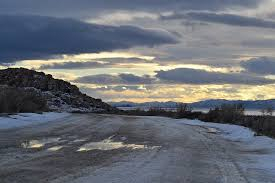
Ice slips! You know that, even if you haven't lived in icy countries. But you don't know why. It's due to a film of water that is created due to friction. It would be much thinner than you can expect and extremely viscous, like the crushed ice you drink on hot days. Researchers from the CNRS and ENS-PSL, with support from the École polytechnique, showed how it works.
In a study that appeared in Physical Review X, the slipperiness of ice is said to be due to the creation of a thin layer of water that is created due to friction. It enables an ice skater to "surf" over this film. Its properties have never been assessed nor is its thickness known. Even its existence is the subject of debate. Moreover, as water is a poor lubricant, how does a liquid film bring down friction and make ice slippery?
The results counter some of the theoretical descriptions that characterize friction on ice. Strange features of meltwater are important to guage its properties. They can give insights into how ice enables gliding for sportspersons in winter. It can also make us understand how to avoid skidding on roads and rivers covered with ice.
Scientists from the Laboratoire de physique de l'ENS (CNRS/ENS-PSL /Sorbonne Université/Université de Paris), got into a joint collaboration with researchers from Laboratoire d'hydrodynamique (LadHyX,CNRS/École polytechnique) to come up with a special device that had a a tuning fork, just like one used in a musical instrument. It is able to "hear" whatever forces are working when ice glides precisely. Although the instrument measures just a few centimetres, it has the minute sensitivity to explore the properties of ice on a nanometric scale.
The device helped to show that due to friction, a film of liquid gets generated and leads to slipperiness. But strangely, the film has a thickness that measures a few hundred nanometres to a micron, or one-hundredth the thickness of a strand of hair. It is thinner than scientists had deduced in theory. Unexpectedly, the scientists also find out why the film is not just "simple water," but water that becomes as viscous as oil and shows some complicated viscoelastic characteristics.
Hence, this shows that surface ice does not totally become liquid water but is in a mixed state just like "snow cones" or a blend of ice water and crushed ice. It is the viscosity, therefore, that leads to the sliding.








